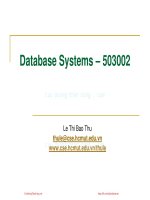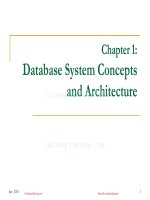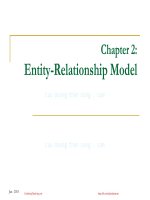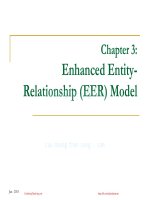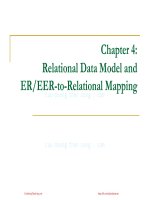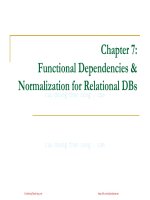cơ sở dữ liệu lê thị bảo thu chương ter 07 functional dependencies normalization for relational dbs sinhvienzone com
Bạn đang xem bản rút gọn của tài liệu. Xem và tải ngay bản đầy đủ của tài liệu tại đây (1.89 MB, 88 trang )
Chapter 7:
Functional Dependencies &
Normalization for Relational DBs
CuuDuongThanCong.com
/>
Contents
1
Introduction
2
Functional dependencies (FDs)
3
Normalization
4
Relational database schema design algorithms
5
Key finding algorithms
Jan - 2015
CuuDuongThanCong.com
/>
2
Contents
1
Introduction
2
Functional dependencies (FDs)
3
Normalization
4
Relational database dchema design algorithms
5
Key finding algorithms
Jan - 2015
CuuDuongThanCong.com
/>
3
Top-Down Database Design
Mini-world
Requirements
E1
Relation schemas
Jan - 2015
CuuDuongThanCong.com
R
Conceptual schema
E2
/>
4
Introduction
Each relation schema consists of a number of
attributes and the relational database schema
consists of a number of relation schemas.
Attributes are grouped to form a relation
schema.
Need some formal measure of why one
grouping of attributes into a relation schema
may be better than another.
Jan - 2015
CuuDuongThanCong.com
/>
5
Introduction
“Goodness” measures:
Jan - 2015
Redundant information in tuples.
Update anomalies: modification, deletion,
insertion.
Reducing the NULL values in tuples.
Disallowing the possibility of generating spurious
tuples.
CuuDuongThanCong.com
/>
6
Redundant information
The attribute values pertaining to a particular
department (DNUMBER, DNAME, DMGRSSN)
are repeated for every employee who works for
that department.
Jan - 2015
CuuDuongThanCong.com
/>
7
Update anomalies
di thuong
Update anomalies: modification, deletion,
insertion
Modification
Jan - 2015
As the manager of a dept. changes we have to update many
values according to employees working for that dept.
Easy to make the DB inconsistent.
CuuDuongThanCong.com
/>
8
Update anomalies
Update anomalies: modification, deletion,
insertion
Jan - 2015
Deletion: if Borg James E. leaves, we delete his tuple
and lose the existing of dept. 1, the name of dept. 1,
and who is the manager of dept. 1.
CuuDuongThanCong.com
/>
9
Update anomalies
Update anomalies: modification, deletion,
insertion
Insertion:
Jan - 2015
How can we create a department before any employees
are assigned to it ?
CuuDuongThanCong.com
/>
10
Reducing NULL values
Employees not assigned to any dept.: waste the
storage space.
Other difficulties: aggregation operations (e.g.,
COUNT, SUM) and joins.
Jan - 2015
CuuDuongThanCong.com
/>
11
Generation spurious tuples
gia mao
Disallowing the possibility of generating spurious
tuples.
EMP_PROJ(SSN, PNUMBER, HOURS, ENAME,
PNAME, PLOCATION)
EMP_LOCS(ENAME, PLOCATION)
EMP_PROJ1(SSN, PNUMBER, HOURS, PNAME,
PLOCATION)
Generation of invalid and spurious data during JOINS:
PLOCATION is the attribute that relates EMP_LOCS and
EMP_PROJ1, and PLOCATION is neither a primary key
nor a foreign key in either EMP_LOCS or EMP_PROJ1 .
Jan - 2015
CuuDuongThanCong.com
/>
12
Generation spurious tuples
Jan - 2015
CuuDuongThanCong.com
/>
13
Generation spurious tuples
Jan - 2015
CuuDuongThanCong.com
/>
14
Generation spurious tuples
Jan - 2015
CuuDuongThanCong.com
/>
15
Summary of Design Guidelines
“Goodness” measures:
Normalization
It helps DB designers determine the best relation
schemas.
Redundant information in tuples
Update anomalies: modification, deletion, insertion
Reducing the NULL values in tuples
Disallowing the possibility of generating spurious tuples
A formal framework for analyzing relation schemas based on their
keys and on the functional dependencies among their attributes.
A series of normal form tests that can be carried out on individual
relation schemas so that the relational database can be
normalized to any desired degree.
It is based on the concept of normal form 1NF, 2NF,
3NF, BCNF, 4NF, 5 NF.
Jan - 2015
CuuDuongThanCong.com
/>
16
Contents
1
Introduction
2
Functional dependencies (FDs)
3
Normalization
4
Relational database schema design algorithms
5
Key finding algorithms
Jan - 2015
CuuDuongThanCong.com
/>
17
Functional Dependencies (FDs)
Definition of FD
Direct, indirect, partial dependencies
Inference Rules for FDs
Equivalence of Sets of FDs
Minimal Sets of FDs
Jan - 2015
CuuDuongThanCong.com
/>
18
Definition of Functional dependencies
Functional dependencies (FDs) are used to
specify formal measures of the "goodness"
of relational designs.
FDs and keys are used to define normal
forms for relations.
FDs are constraints that are derived from
the meaning and interrelationships of the
data attributes.
A set of attributes X functionally determines
a set of attributes Y if the value of X
determines a unique value for Y.
Jan - 2015
CuuDuongThanCong.com
/>
19
Definition of Functional dependencies
X -> Y holds if whenever two tuples have the same value
for X, they must have the same value for Y
For any two tuples t1 and t2 in any relation instance r(R):
If t1[X]=t2[X], then t1[Y]=t2[Y]
X -> Y in R specifies a constraint on all relation
instances r(R)
Examples:
social security number determines employee name:
SSN -> ENAME
project number determines project name and location:
PNUMBER -> {PNAME, PLOCATION}
employee ssn and project number determines the hours
per week that the employee works on the project:
{SSN, PNUMBER} -> HOURS
Jan - 2015
CuuDuongThanCong.com
/>
20
Definition of Functional dependencies
If K is a key of R, then K functionally
determines all attributes in R (since we never
have two distinct tuples with t1[K]=t2[K]).
Jan - 2015
CuuDuongThanCong.com
/>
21
Functional Dependencies (FDs)
Definition of FD
Direct, indirect, partial dependencies
Inference Rules for FDs
Equivalence of Sets of FDs
Minimal Sets of FDs
Jan - 2015
CuuDuongThanCong.com
/>
22
Direct, indirect, partial dependencies
Direct dependency (fully functional
dependency): All attributes in a R must be fully
functionally dependent on the primary key (or
the PK is a determinant of all attributes in R).
Performer-id
Performername
Performertype
Performerlocation
Jan - 2015
CuuDuongThanCong.com
/>
23
Direct, indirect, partial dependencies
Indirect dependency (transitive dependency):
Value of an attribute is not determined directly
by the primary key.
Performer-id
Performername
Performertype
Fee
Performerlocation
Jan - 2015
CuuDuongThanCong.com
/>
24
Direct, indirect, partial dependencies
Partial dependency
Composite determinant: more than one value is required to
determine the value of another attribute, the combination of
values is called a composite determinant.
EMP_PROJ(SSN, PNUMBER, HOURS, ENAME, PNAME, PLOCATION)
{SSN, PNUMBER} -> HOURS
Jan - 2015
Partial dependency: if the value of an attribute does not depend
on an entire composite determinant, but only part of it, the
relationship is known as the partial dependency.
SSN -> ENAME
PNUMBER -> {PNAME, PLOCATION}
CuuDuongThanCong.com
/>
25
